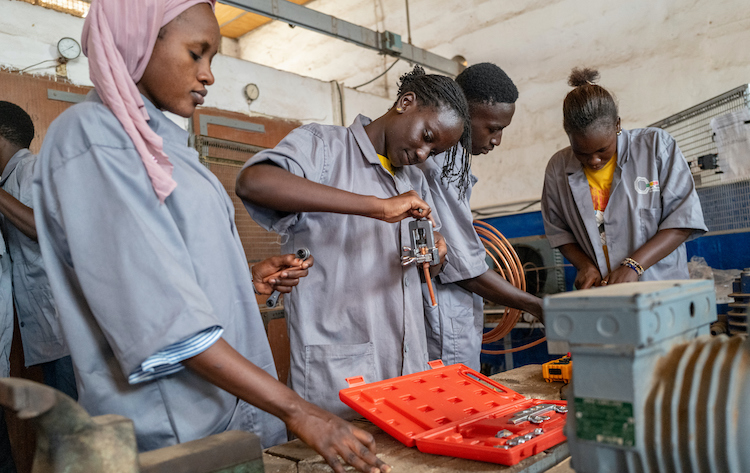Imagine hopping on a school bus and being transported to an immersive, educational tour of the inside of the human body — and no, not on a fictional episode of “The Magic School Bus.” This is the kind of experience that Meta hopes to enable for students, digitally, through its Quest virtual reality headsets.
Later this year, Meta will launch new software for educators that aims to make it easier to use its VR headsets in the classroom. The tools will let teachers manage and program multiple Quest headsets at once, give them access to a range of education-related apps and provide greater oversight and control of how students are using the devices.
Bringing VR into more classrooms could enable new kinds of learning opportunities, such as allowing high school drama students to feel like they’re having an immersive, real-time experience watching Shakespeare performed at the Globe Theatre in the 17th century. But VR also creates thorny questions about digital safety and the potential harm to humans who are having more digital interactions and fewer in-person ones, as well as questions about whether incorporating the technology in classrooms would really improve learning.
“You will be able to teach biology and chemistry without having to have a fully equipped laboratory in the future … you will be able to walk the streets of Ancient Rome with students,” Meta’s President of Global Affairs Nick Clegg, who has overseen the Quest for education initiative, told me in an interview conducted via virtual reality ahead of the announcement.
The push to make VR more accessible for teachers and students is part of Meta’s long-term, multi-billion dollar bet on the so-called metaverse: The company believes that in the coming years, humans will use virtual reality headsets to spend increasing amounts of time working, learning and interacting in a digital version of the world.
Still, it remains unclear just how useful virtual reality is in helping students learn better.
“I think that (VR) is one area that really would benefit from having some additional research,” said Vincent Quan, an education researcher and co-executive director of the Abdul Latif Jameel Poverty Action Lab. “With technology, sure, it can have a lot of promise, but at the same time, it can also be a lot of hype, and I think it’s important to rigorously evaluate these types of technologies … sometimes you don’t know if it’s just flashy and innovative and cool versus actually impactful.”
Quan, who in 2020 was part of a group of researchers who published a broad review of studies on the impact of education technology, said the findings on whether classroom tech leads to improved learning are mixed — and are dependent on what tools are used and how. Meta, meanwhile, points to early studies on the benefits of VR, such as a PwC report from 2022 that found that students who received a “soft skills” training in VR felt more engaged than those who were trained in a more traditional learning environment.
Clegg said the new Quest features are simply a response to requests from teachers who are already using the devices, as well as a growing crop of developers building educational apps for the headsets.
New Mexico University is using the headsets to teach criminal justice students to investigate virtual crime scenes, and Morehouse College has developed a “digital twin campus” to teach students a range of subjects through VR, both through a partner program with Meta to test educational applications of the technology.
“They want this technology to be available to them out of the box, they don’t want to mess around, wasting time individually configuring each of them, and of course, crucially, they want full, complete visibility and control about what students are experiencing,” Clegg said of the feedback from educators who have used the devices that informed the new Quest education software offering.
For students aged 13 to 17, Clegg added that the new software includes special protections, such as blocking access to the Meta Quest app store so they can use only applications that are pre-programmed by teachers on the devices.
Questions about VR in the classroom
The cost to incorporate VR headsets in the classroom could be a hurdle to adoption for the many schools already struggling with limited resources. While cheaper than some other headsets on the market, Meta’s Quest 3 devices still start at $499 each.
“Sometimes with these new ed tech tools, they seem really promising, they seem in theory like they should level the playing field,” Quan said. However, “the kids who would most benefit from additional instruction, they don’t have the resources of the infrastructure to utilize the technology or they don’t really know about the technology, so they don’t end up utilizing it and then it actually makes the inequality gap widen.”
Clegg acknowledged that cost is “always, candidly, an issue when you have new technology being introduced into education.”
“It costs something, so any cost of course is more burdensome for those who have fewer means,” he said. However, he added that experiences like being able to virtually take students to “a museum rather than having to spend the expense of actually transporting them to your nearest museum … I think it could make many really valuable education experiences much cheaper” in the long term.
I also asked Clegg about concerns that having a classroom full of students wearing headsets and interacting in a digital world rather than talking face-to-face — or conducting a virtual biology lab instead of engaging with the physical world — could to some people feel a bit dystopian. He disagrees.
Clare Duffy/CNN











